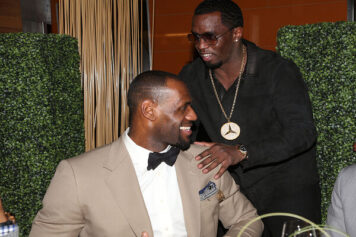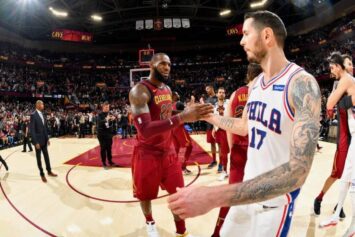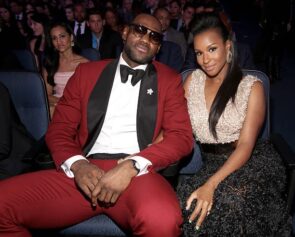Chris “Birdman” Andersen looks like a cross between an ’80s punk rocker and rapper Machine Gun Kelly. His basketball skills are average. He doesn’t get you but five points per game and some hustle plays. But those tattoos… His colorful, extensive body art presents a wild aesthetic and represents a form of skin decorating, which is one of the most widespread and universal forms of expression.
So it’s not surprising that Andersen’s popularity is growing with every magazine cover, telecast, podcast or radio interview showcasing the NBA’s most tatted-up baller . The tattoo artist and the NBA player have become like the music artist and his traveling “dope man” back in the ’70s and ’80s – inseparable.
As far back as man’s primordial feeling, when he found himself without great amounts of body hair, his inclination was to take a blackened stick from the fire and decorate his skin. In this way, he became camouflaged or protected as the animals were.
At a time when body art has re-exploded as a cultural phenomenon and fashion encourages individual expression, Andersen’s managed to parlay a turmoil-filled career as an energetic role player into firm standing as one of the NBA’s most popular faces, through his cultural appeal and antagonistic, high-energy basketball grit.
“He’s like the ambassador for body art as a canvas,” said tattoo historian Ike Briggs, of Blazin' Ink Apparel. “Body art, period, is a huge movement around the world and Birdman has been able to cross culture, sports and tattooing and bring it even more to the mainstream.”
Andersen’s knack for flying across the court, dunking over opponents and sending shots into the stands, earned him his “Birdman” nickname. His elevated visibility as an NBA player and tattoo-blanketed body has helped him transcend the sport of basketball and create a unique pocket of celebrity for himself.
Birdman Fever is spreading and he’s got people doing his dance and feeling his handle.
“People just flapping their wings, driving down the road, not even knowing it’s me beside ’em,” Andersen said during the NBA Finals against San Antonio. “And I roll my window down and I start flapping with them. They realize it’s me, they get overjoyed.”
It all begins with his eye-grabbing tats and the love he gets, off the rip, from body art and “free expression” appreciators of all ages.
“People look at body art as a recent cultural phenomenon and cosmetic movement, but it is a colorblind movement that dates back to the Egyptians and biblical times,” Briggs added. “Kings, queens and goddesses used tattoo marking to express stories and it was a great symbol of generational royalty.”
Andersen is balling for King James’ royal family in Miami. His road to these NBA finals has been tumultuous, but always interesting. The scars of his life are hidden under his multi-colored skin, which also projects the passion and uniqueness of his choices of expression.
It all comes together to make Birdman one of those cats that just stands out. He always seems to make an impact on someone or some aspect of the game.
Andersen helped a shooting-slumped Miami team edge a tough Pacers team in seven games in the ECF by matching the Pacers’ intensity and hitting 16-of-16 field goals at one point.
Sure, he received a Game 6 ejection for the flagrant on Hansbrough, and he was jawing with the Pacers all series, but that flip side of Andersen – the one that helps him prove that he’s not just a freak show but a real NBA contributor – is one of the things people dig about him.
There he was in a crucial Game 2 of the NBA Finals on Sunday, efficiently hitting three of four shots from the floor to help Miami even the series with San Antonio at 1-1.
Perfection has never been a goal of Andersen’s. Neither has failure. Survival has been his driving force. His sick work ethic helped him become the only player out of unheralded Blinn College in Brenham, Texas to make it to the NBA. This was after his dad left him and his mom Linda at a young age, forcing them to grind off the land. Things got so bad that during Andersen’s middle school years, he and his siblings were sent to a group home in Dallas for three years.
The only reason he even started balling was because the varsity coach at his high school told him he could get a college scholarship. That was a road to a much better life, so he went hard to make it happen. Going hard is a recurring theme for Andersen. He went undrafted in ’99 and had to ball in China for a minute, but eventually he got that NBA cake.
The fast life almost clipped his wings for good, though. When you are balls-to-walls with everything, like Birdman, sometimes you’re going to crash and burn. Sometimes it’s comical and for entertainment, like the “iconic for all the wrong reasons” performance, when he flubbed on the same dunk eight straight times. But that go-hard mentality has produced more-grave results, as well, like violating the NBA’s substance abuse policy and being suspended from the game for almost two years.
Not surprisingly, this hasn’t damaged Andersen’s public image. If anything, people who have experienced similar tough circumstances as youth and adults, but hope to persevere like Andersen on the come-up, look to him as inspiration.
Andersen isn’t the first NBA player with pedestrian skills to transcend sports and become a cult-icon of sorts. People came out to see cats like 5´3 Muggsy Bogues, 7´7 Manute Bol, backboard obliterator Darryl “Chocolate Thunder” Dawkins and pugnacious Dennis Rodman, for their physical uniqueness and/or personality as much as their ability.
And then there’s the fact that Andersen is as much a victim of circumstance and perfect timing, as anything else. Tatts are what’s popping, the Heat is what’s up in NBA circles, and he’s part of that traveling rock band Miami’s become since the “Big Three” hit town in 2010.
You’ll find that most veteran-NBA players are favored by the 30- to 50-year-old fans, and the new jacks like Kyrie Irving and Derrick Rose, are worshipped by the college heads and younger cats. Birdman seems to have an almost equal fan base of Generation X and Generation Y supporters.
It can largely be contributed to his immersion in the diverse, non-discriminatory and unrestrictive tattoo culture, which gets him love from all sides.
At Heat games he has a cult following of people who dress themselves and their kids up in Andersen’s unique look. He’s even gained the good graces of animal lovers across the world, when he and his extensive tattoo collection starred in an ad for PETA’s iconic “Ink, Not Mink” campaign, encouraging others to show off their own skin and let animals keep theirs.
He says playing in Miami works for him, and he’s looking to do everything in this NBA Finals, from body-guarding LBJ to famously taunting San Antonio, in order to continue his NBA success after this season’s pro-rated $700,000 contract is up. And Andersen has said himself that the Heat allow him a comfortable amount of personal freedom.
Though Anderson’s role is no more important than Udonis Haslem’s or Tiago Splitter for the Spurs, ten years from now, few will remember those cats as anything more than fill-in pieces on championship squads with immortal ballers. Birdman’s legend, however, is growing and he’s formed a lasting bond with fans that will preserve his memory and cultural impact long after these other faceless guys are gone. Take a little time and let that sink for these next few games in the Finals. Birdman, Birdman!



